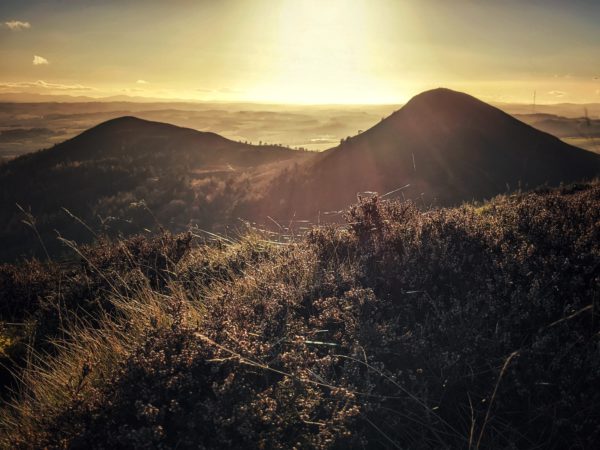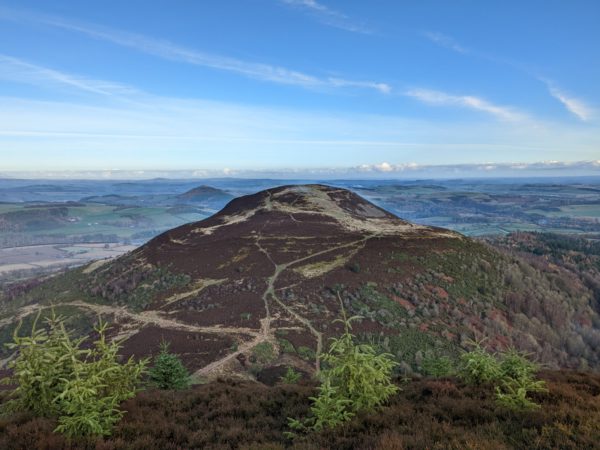By: David C. Weinczok
Hills are so often described as ‘focal points’ in a landscape. But what happens when the hills are shapeshifters? Such is the way of the Eildon Hills, whose three highest peaks are perhaps the most recognisable and beloved landmarks of the Scottish Borders. Their shadows touch, quite literally, upon the remnants of ages past that altogether shaped the identity of the area. In the low winter sun, the shadow cast from Eildon Hill North breaches the boundaries of the vast, and almost entirely vanished, Roman fort of Trimontium astride the River Tweed. It has also been noted, only quite recently, that the Midwinter shadow of Eildon Mid Hill very nearly touches the high altar of Melrose Abbey.
Most would say that there are three Eildons – Eildon Hill North, Eildon Mid Hill, and Eildon Wester Hill. There is, however, a fourth, aptly called ‘Little Hill’, nestled at the edge of a shallow valley on the western edge of the range between Eildon Mid and Eildon Wester hills. Still, from most perspectives it is the three highest peaks that dominate. Depending on where you stand, even this is subject to change. The tendency of these hills – so sudden and magnetic in their otherwise low-lying and placid surrounds – to become three, two, or even one has bolstered belief in their magical quality. Seen from the west and south, for instance from high ground above Sir Walter Scott’s home of Abbotsford or the Minto Hills, they stand as triplets, with Eildon Wester stretching away from the others. From the north, as at the old monastic site of Gattonside, Eildon North and Mid hills appear as twins, with perspective playing tricks as to which is the highest (Eildon Mid Hill comes out on top, barely, at 422 metres compared with Eildon North’s 404). From the east, the three become one as Eildon Hill North seems to engulf them all.
Hollow hills

In the realm of legend, the Eildons are ‘hollow hills’. Much like Arthur’s Seat in Edinburgh, they are said to contain a vast, magical realm within, inhabited by fairy folk and the sleeping warriors of Arthur who will one day awake at the sound of a great horn to sweep evil from the land. Also like Arthur’s Seat, the Eildons are the remains of a volcanic range which fundamentally shaped the landscape they loom over today. Their hollows were long ago filled in by powerful geological forces. Much more recently, people have filled them with stories. One such story is of Thomas the Rhymer, one of the Borders’ most enigmatic sons. In lore he has gone down as a man of prophecy and mystery. In life he was a 13th century multilingual seeker of knowledge steeped in Welsh literary traditions (though he wrote in English) who came to own a small tower house in what is now Earlston. One of his most famous prophecies was that the Atlantic Ocean and the North Sea would one day meet in the middle of Scotland. This arguably became true upon the completion of the Caledonian Canal. Another was that only a dead man could take Roxburgh Castle. In 1460 King James II of Scotland was killed besieging Roxburgh Castle when his own cannon burst its barrel, though the castle did indeed fall soon after.
Thomas’ gift of prophecy was given to him by the Queen of the Fairies. While resting beneath a tree at a site now marked by a small monument called the Rhymer’s Stone, Thomas was beckoned by the Queen to join her in her kingdom within the Eildons. Such was the wealth of this hidden kingdom that the teeth of sheep grazing on the Eildons’ slopes were said to turn yellow from gold dust! A series of otherworldly wonders presented themselves on the way, including a red river representing the amount of blood shed on earth in a single day and an orchard filled with apples grown out of all the curses people uttered aloud. The Fairy Queen presented him with one apple which gave him a tongue that could never lie, and so Thomas of Ercildoun became the Rhymer.
The greatest hilltop settlements in Scotland

More tangibly, Eildon Hill North was once among the greatest hilltop settlements in Scotland. Though almost nothing aside from much-reduced earthen ramparts are visible to the naked eye, the broad summit was once entirely enclosed by a wall containing nearly 500 huts borne on wooden platforms. During the Bronze and Iron Ages it could support upwards of 3,000 people, 500 more than the population of modern Melrose. Recent excavations unearthed evidence that Eildon Hill North was fortified well into the Early Medieval Period, with the invading Northumbrians of the 7th century referring to it as ‘Aeled-Dun’, ‘Fire Hill’.
All this overlooked Trimontium, a sprawling legionary fortress that saw intermittent use by various waves of Roman would-be conquerors for three centuries. Astonishing finds including glittering metal cavalry helmets, hoards of gladius swords and other panoplies of war, and bronze wine jugs have been recovered from the fields of crops which now conceal this remnant of Empire. Like the dot at the bottom of a question mark, Eildon Hill North is punctuated by small dip, all that remains of a Roman watch tower. What was the relationship between this mighty native hilltop haven and the legionaries in its shadow? Many Roman objects have turned up in sites occupied by local tribes and vice versa, so it was not all ‘us versus them’. Still, there are many questions which the Eildons yet hold the answers to.
The best way to know the Eildons is to walk them. Each is formidable in its own way, yet more than worth the effort. The summit of Eildon Mid Hill can seem almost sub-Arctic, scree-scattered and blasted by winds with tiny conifers eking out from the thin soils between stones. Eildon Wester Hill, with its steady path towards the Eildons’ furthest outstretched point, feels like a south-facing pulpit overlooking the fertile lands leading to the Cheviots and England beyond. From atop Eildon Hill North, the architectural wonder of Melrose Abbey far below seems like little more than a doll’s house, putting our earthly and spiritual ambitions into perspective. A strangely still lochan, its waters too murky to reveal their depths and its intrigue enhanced by its absence from the OS map, rests by Little Hill. Set within the amphitheatre of the Eildons, the romantic in me wonders what treasures might have been deposited in its depths long ago by the people of the hills. In every sense of the term, there are many Eildons. Their meaning transforms with each person’s motivations for seeking them, and even their appearance shifts with each new approach. What do the Eildon Hills hide? Nothing less than the stories and histories we scatter across their slopes.

